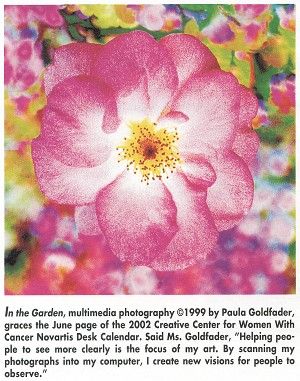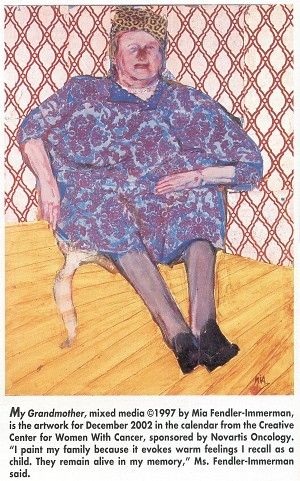Creative Center for Women Celebrates Fifth Arts Calendar
NEW YORK-A photograph of a stone mansion half hidden in violet light decorates the February page of the 2002 Creative Center for Women With Cancer Novartis Desk Calendar. The photographer, Susan Markisz, writes in the calendar that "cancer, like photography, is both a positive and negative process, one that does not quite define me, but which demands interpretation."
NEW YORKA photograph of a stone mansion half hidden in violet light decorates the February page of the 2002 Creative Center for Women With Cancer Novartis Desk Calendar. The photographer, Susan Markisz, writes in the calendar that "cancer, like photography, is both a positive and negative process, one that does not quite define me, but which demands interpretation."

"It’s a calendar of people," said Geraldine Herbert, director and co-founder of the Creative Center for Women With Cancer. "I think what it says it that the people who are diagnosed with cancer become so much more when you look at this piece of art. They’re creative, expressive individualswhich is really the basis of why we started the center."
The Center is 7 years old, and this is the fifth year the calendar has been published and sent to doctors and nurses across the country. The demand for it has increased: This year 125,000 calendars were distributed, calendars which have given 60 women artists an opportunity to show images of their artwork to people across the country and to present their statements.
In recent years, there have been many signs of growth at the Center, a nonprofit organization in Manhattan that helps women, men, and children with cancer improve the quality of their lives through creativity.
Its Hospital Artists-in Residence Program, begun 3 years ago as a pilot program, has grown dramatically. The
program offers hospital patients opportunities to explore their creativity at the bedside, in workshops, and in hospices and palliative care programs. Today 12 hospitals in the New York City area take part, and the artists work with 5,000 patients a year.
The growing demand for artists-in-residence has led to the creation of an institute to train them. This May, the first Creative Center National Institute, a week-long training program, will be held at the Center to prepare artists from across the country to become artists-in-residence. The Institute will offer internships at New York Presbyterian Hospital, New York University Hospital, and Lenox Hill Hospital, and will include seminars, workshops, and open studios led by a faculty of artists, physicians, nurses, and psychologists, with participation by the Museum of Modern Art, the Whitney Museum of American Art, and several New York art galleries.

The Center has also offered more programs since its move from a small office into a spacious loft. Ms. Herbert said that being in the new space "has enriched and expanded us." She said the move made it possible to have exhibitions, more free workshops, and a coffee house on Friday nights where the public can hear members play music or sing.
The recent workshops have included classes in watercolor, still life painting, paper cutting, toy theater, puppetry, and belly dancing; a drumming circle; literary workshops; and a guided tour of the Whitney Museum of American Art.
Another class, "Physical Narratives," will be led by a choreographer who is a cancer survivor. She teaches students that their bodies encompass their memories, identity, and history, and she helps students create movement by connecting to their bodies.
The Center also offers scholarships for extended workshops in the arts at the Vermont Studio Center, Johnson, Vermont, an international artists community, and at the Educational Alliance and the Craft Students League in New York.
"Evanescence" is the name of a photographic exhibit at the Center that presents intimate "portraits" of fiery red nasturtiums, ripe red dahlias, and other flowers with fleeting beauty. "These photographs connect the personal with the beauty and power of the natural world, which brings me peace regardless of my external life circumstances," photographer Jayne Mangino, wrote in her artist’s statement. Ms. Mangino also studies painting at the Center. She said that art classes were more manageable at the Center for her because some classes are held in the daytime and the term is shorter than at most art schools. "There’s no stigma if you miss classes. People will understand when you’re sick." Ms. Mangino cautioned that when people look at her photographs, "if they are just seeing pretty pictures, they’re missing the point. All the work is about life and death." For more information about the Creative Center, please visit its website at www.ccwconline.org.
Newsletter
Stay up to date on recent advances in the multidisciplinary approach to cancer.
Elevating the Quality of Cancer Care via Cross-Department Collaboration
Experts from Sibley Memorial Hospital discuss how multidisciplinary work has enhanced outcomes such as survival and resource use at their institution.